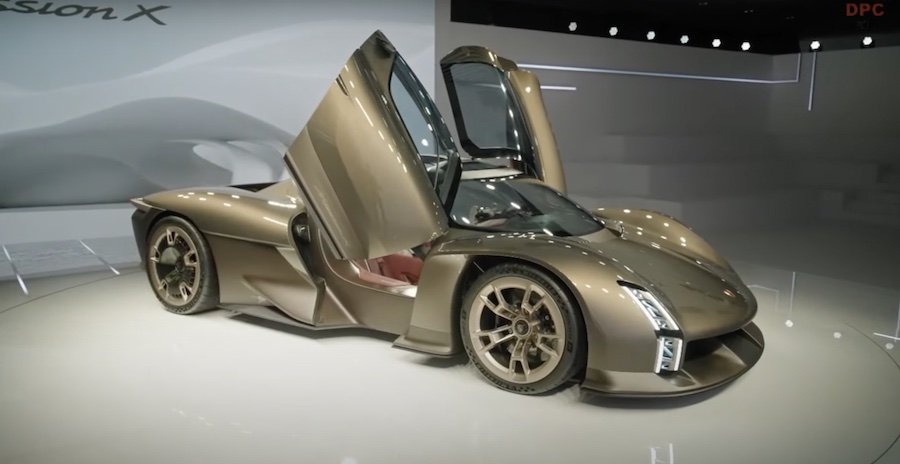New Porsche Mission X concept is electric 918 Spyder successor

The stunning new Porsche Mission X, unveiled to mark the 75th anniversary of the brand, is an electric hypercar concept that previews a potential successor model to the Carrera GT and 918 Spyder.
The rear-drive two-seater is intended as a lightweight ‘super-sports car’ with a high-performance electric powertrain – which could potentially offer around 1500bhp – and a goal to become the fastest road-legal car on the Nürburgring Nordschleife. It would effectively fill the gap at the top of the Porsche line-up that has been open since the 918 Spyder went out of production in 2015.
Porsche boss Oliver Blume said the model would be “a technology beacon for the sports cars of the future”, adding: “It picks up the torch of iconic sports cars of decades past: like the 959, the Carrera GT and the 918 Spyder before it, the Mission X provides critical impetus for the evolutionary development of future vehicle concepts.”
The Mission X name is a clear reference to the 2015 Mission E concept, which previewed the Taycan that went into production in 2019. In 2021 Porsche showed a Mission R, which hints at the electric 718 Boxster and Cayman successors expected around the middle of this decade.
Based on those timelines, any production car based on the Mission X would be unlikely to appear until around 2027. It is understood that the concept is being developed purely by Porsche and isn’t linked to Rimac, the Croatian hypercar firm Porsche holds a major stake in.
The Mission X has relatively compact dimensions at around 4.5m long with a wheelbase of 2.73m – which, Porsche notes, makes it a close match for the Carrera GT and 918 Spyder that it shares a philosophical lineage with. It stands less than 1.2m tall and sits on 20in wheels at the front, with 21in versions at the rear, a move designed to optimise aerodynamics.
Porsche hasn’t divulged any technical details of the intended powertrain for the Mission X – but it has laid out a ‘technical vision’, giving a series of objectives that engineers are aiming to hit for it to reach series production.
These include that Nürburgring lap record target – the current record is held by the Mercedes-AMG One, which lapped the 12.944-mile circuit in 6min 35.18sec. The focus will be as much on efficiency and lightweight design – a traditional challenge for performance EVs – with an intended power-to-weight ratio of one metric horsepower (1PS, or 0.986bhp) per kg.
Porsche has not disclosed a target weight, but given the firm’s focus on lightweight design, the goal is likely to be close to a current 911 – around 1400 or 1500kg. That, in turn, would suggest a power output of close to 1500bhp.
Porsche has confirmed that the battery will be installed behind the vehicle’s seats – effectively where the engine in a traditional mid-engined hypercar would sit. Termed an ‘e-core’ concept, it mirrors the approach taken by Porsche with the Mission R, and helps to both centre the mass in the car for better handling and allow for a lower floor than with a traditional battery skateboard chassis.
Another engineering objective is for the machine to produce downforce levels “well in excess” of the current 911 GT3 RS – which can create 860kg at 177mph.
Meanwhile, Porsche says it is also chasing “significantly improved” charging performance for its 900V architecture, with a goal for the Mission X to charge twice as quickly as the Taycan. That can charge at a peak of 225kW, which suggests Porsche is aiming for a speed of 450kW. Such fast charging would help to enable the car to be offered with relatively small batteries, thereby reducing weight.
Porsche has given no details on what type or size of batteries the concept will use, but its hypercar performance means the firm is likely to be looking at high-performance units developed for motorsport or hypercars.
The design of the car is intended to fuse performance with “modern luxury” and a number of design cues from Porsche’s ultra-successful Le Mans 24 Hours sports prototypes are evident.
There is a lightweight glass dome with a carbonfibre-reinforced plastic exoskeleton that extends over both seats. Le Mans-style doors, similar to those used on the legendary 917 racer, are fixed to the A-pillar and open forwards and upwards.
The machine features a reworked version of Porsche’s ‘four-point’ light graphic, with vertical headlights inspired by the 906 and 908 consisting of framed LED light modules. At the rear, there is a full-length light unit and transparent, illuminated Porsche lettering.
The aerodynamic design focus can be seen throughout the machine, in both its general presence and in smaller details, including near-transpired aero blades on the rear wheels, which feature a turbine-like design to offer improved cooling to the rear brakes.
Inside, the driver focus of the Mission X is signalled by the motorsport-style asymmetrical layout - and the use of different colours for the two seats. Both racing seats feature six-point harnesses, and there is a motorsport-style open-top steering wheel that has paddle shifters attached.
To ensure that any future Nürburgring records can be captured, the car features numerous built-in cameras, which are activated by a special record button on the multi-purpose controlled.
The passenger side has a ‘bayonet system’ built into the instrument panel that a stopwatch module can be fixed to, in order to provide lap times or other driving data during road or track use.
The Mission X was unveiled on 8 June, the 75th anniversary of the day the marque was granted a permit to begin production of the 356 No 1 Roadster, effectively the birthday of the brand.
Related News


